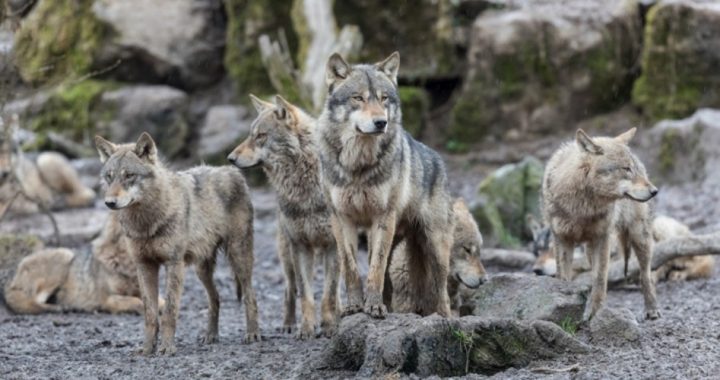
Podcast: Play in new window | Download ()
Subscribe: Android | RSS | More
Hours before a King County Superior Court judge ordered a temporary stay of execution for them, four wolves in Northeastern Washington were killed by officials of the Washington Department of Fish and Wildlife (WDFW). Prior to Friday’s culling, four additional wolves belonging to the same pack were destroyed between July 31 and August 13, bringing the total number of kills to eight.
Last year, The New American reported on serious wolf depredation that ranchers face in the region.
The Center for a Humane Economy, a left-wing NGO, which is openly hostile to ranchers, scored a victory from the judge in the form of a temporary injunction ordering the state not to kill any more wolves, but the kills had already been carried out early on Friday morning.
In a statement, the Center for a Humane Economy blasted the WDFW and the ranchers involved in the killing. “This is a bittersweet courtroom victory because the Department of Fish and Wildlife gunned down four more wolves on the very morning of the judicial proceeding,” said Wayne Pacelle, the president of organization.
One wolf of the pack, which was formerly known as the Profanity Peak Pack, remains alive. That wolf’s fate is yet to be decided.
Except for the last remaining wolf, the pack was eliminated because WDFW confirmed that they have killed or seriously injured at least 14 cattle in the last 10 months. Len McIrvin, proprietor of the Diamond M Ranch, the ranch most profoundly affected by the wolf pack, says that number is quite a bit low. “It’s over thirty (kills) in the last year,” said Len McIrvin, the proprietor of the Diamond M. As McIrvin explains it, often the WDFW will investigate a depredation and determine that wolves might have eaten the livestock, but are reluctant to list that as the cause of death.
“Many years we’re losing 70 head per year,” McIrvin stated. “We’ve had several years where we can document [that we lost] 70 head.”
Lethal removal is the option of last resort for wolf packs that have become too aggressive and too habituated to a human-involved food source — in this case a cattle ranch — to be allowed to stay in the vicinity. Ranchers must meet an extremely high standard of evidence to get the state to act against wolf depredation. Prior to any state intervention in cases of wolf depredation, ranchers must prove to the WDFW that they took reasonable, non-lethal steps to protect their livestock.
Even so, hostile NGOs accuse the family of not taking such measures. “The family … refuses to take commonsense measures to protect its cattle from predators,” according to the Center for a Humane Economy’s statement.
But “commonsense measures” are in the eye of the beholder. One such “commonsense measure” that NGOs and media have endorsed is the use of air dancers, those floppy, inflated stick men you often see in front of car dealerships, to scare the wolves away. While this is the one non-lethal measure of dealing with wolves that McIrvin does not have personal experience with, he has done everything the WDFW has asked.
“If you’re going to get any help from [the WDFW], you better live by their recommendations,” McIrvin told the Capital Press in July.
It’s estimated that each wolf killed by the WDFW costs the state $20,000. But that cost is inflated simply because it’s a government operation involving multiple personnel and helicopters to accomplish the task. It would cost far less (nothing, in fact) if the government would simply allow ranchers to kill problem wolves by themselves.
And wolf depredation costs ranchers quite a bit more than the wolf kills cost the government. “In the last ten years, we’re well over a million dollars in actual costs from the wolves,” McIrvin said.
Pacelle accused the WDFW of acting in “tremendously bad faith,” by killing the wolves when they did. “It’s like, ‘Okay, we’ve got to get these wolves now, in case the judge stops us,’” Pacelle said.
But WDFW spokesperson Staci Lehman said it was a case of “unfortunate timing,” and nothing nefarious was behind the killing of the wolves in the hours prior to their judicial reprieve.
“It’s always unfortunate whenever we have to remove wolves,” Lehman said. “It’s never taken lightly by anybody at the department.”
Ranchers in Washington and the entire Northwest have been under attack by well-funded NGOs such as the Center for a Humane Economy, the Center for Biological Diversity, and Animal Wellness Action, who attack through the courts whenever the state finally decides that the killing of wolves is necessary. Whenever the WDFW decides a kill is necessary, these NGOs go into attack mode and immediately ask for court relief. In this case, the court injunction came too late to save the predators.
Wolves had been previously wiped out in almost all of the lower 48 states and were gone entirely from Washington State and the entire Northwest United States, excluding Alaska. They began to reemerge in 1995 during the Clinton era as Canadian wolves were trapped and reintroduced to Yellowstone Park and Central Idaho under the auspices of the Endangered Species Act.
That reintroduction, along with the more natural drifting of wolves from Canada into Montana, have strained the resources of ranching families such as the McIrvins. And strained resources are not the worst of the problems for the McIrvins.
Environmentalists have threatened the family with physical harm on several occasions. In the past, the family has received death threats, not only directed at those involved in the ranching operations, but at their children as well. When the news of this latest kill hit, the threats began anew.
“It’s started again,” McIrvin said. “We’ve had two or three really bad calls today.”
The FBI is investigating the threats against the family. Such threats are acts of domestic terrorism and need to be treated as such.
Image: Waitandshoot via iStock / Getty Images Plus




